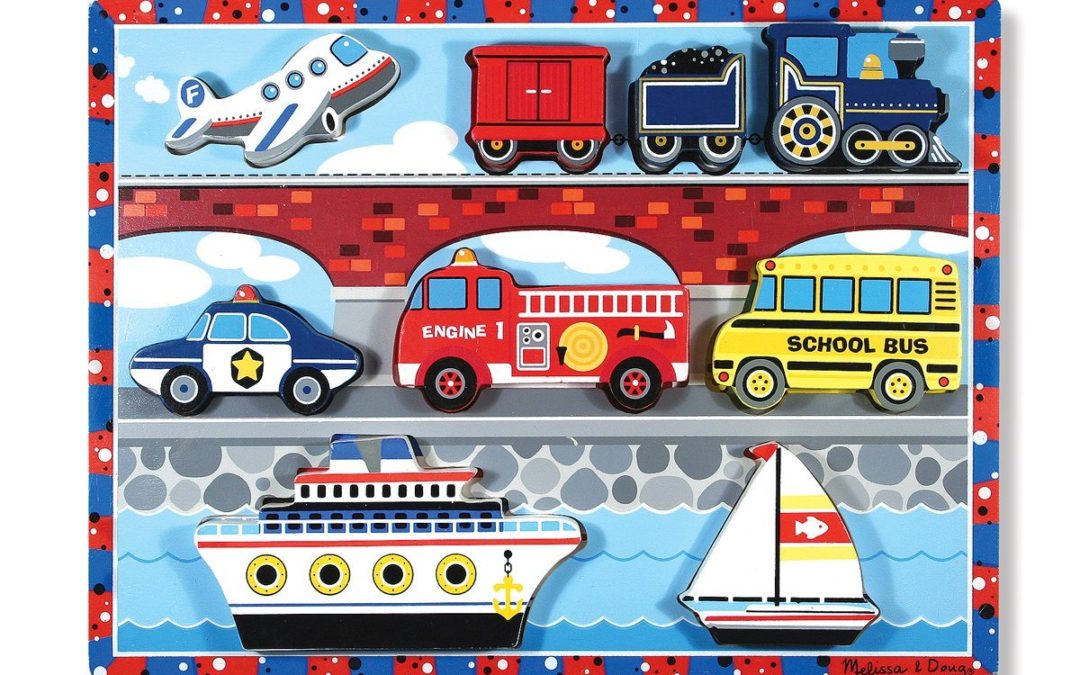
There are so many skills that can be addressed while playing with our favorite toys, including puzzles! Puzzles are a fun way to learn and boost different language skills your child may be developing in a fun and interactive way. Remember, all of this is done with fun play on your child’s level, so using age-appropriate vocabulary and concepts is important.
Make language learning fun today with puzzles!
Basic Vocabulary
Begin play by labeling the pictures on the puzzle pieces. For example, talk about the names of the animals of vehicles (nouns), and what they are doing or can do (verbs).
Concepts
Look at the puzzle pieces and discuss attributes such as color, size, shapes, quantity. For example, target your child’s development with language like, the whale is big, huge, gigantic! You can use superlatives (-er, -est) to describe the pieces as well. For example, The police car is small, the school bus is big, and the ship is the biggest.
Categories, Functions, and Associations
Most puzzles target a single category (ex., ocean animals, farm animals, vehicles, etc.). Discuss the vocabulary, their associations (how they go together) and the category at your child’s level.
For example, when discussing a farm puzzle, make associations such as chickens live in the barn and ducks swim on the pond. For the vehicle puzzle, talk about how people use cars, trucks, airplanes and boats to ride and go places like school or on a trip. Relate the pictures to activities your child is familiar with such as going to the grocery store in the van, going fishing on the lake in a boat, going on an airplane to visit someone, etc.
Even if your child has never been on an airplane or a boat you can talk about when you saw a boat on the lake or an airplane in the sky. When you see a school bus on the street you can discuss that you know where that bus is going! Another way to target categories with puzzles is to hold back a couple of pieces and ask your child what else belongs in the category. Your child has a visual cue if there are pictures under the pieces.
Extend the activity if you can to come up with one more member of the category that is not part of the puzzle. For example, when the pieces for the transportation puzzle are all in you could say, “I’m thinking of a vehicle with two wheels; can you think of what it is?” (and that would be of course a bike or a motorcycle). The bike-motorcycle clues lead to another way of targeting language with puzzles – how are these pieces the same and how are they different? For example, on a barn puzzle you can talk about how chickens and ducks are the same because they both have feathers and can fly, but they are different because ducks swim on the pond and boy chickens (roosters) can crow.
Preposition Words
Use the puzzle board and pieces to target location words such as top, bottom, middle, corner, between, etc. For example, The train is at the top. It’s above the school bus. The sailboat is next to the ship at the bottom of the puzzle.
You can also take turns putting in the pieces and discussing features. For example, you could take your turn with the door puzzle below by putting the cookies in the cookie jar and telling your favorite kind of cookies and then maybe ask your child what her favorite kind of cookie is.
 So much language from puzzles! But remember to have fun too! For more information on puzzle play or to get your child started in their customized therapy plan today, contact us now or give us a call at 919-928-0204.
So much language from puzzles! But remember to have fun too! For more information on puzzle play or to get your child started in their customized therapy plan today, contact us now or give us a call at 919-928-0204.
About the Authors
This blog post was authored by one of our excellent team members here at Emerge. We offer customized therapy plans for children, adolescents, and adults!

